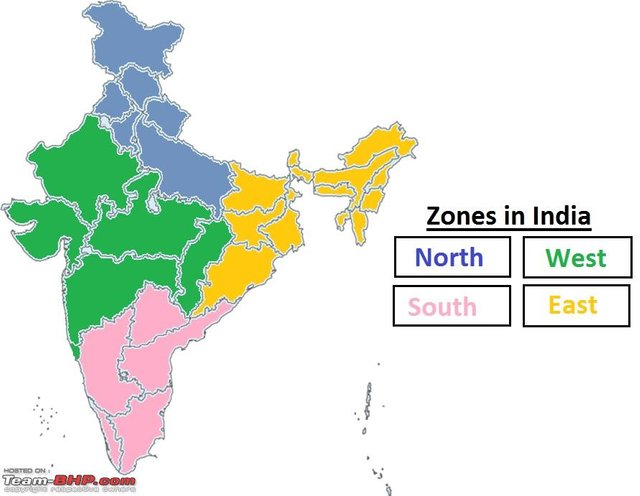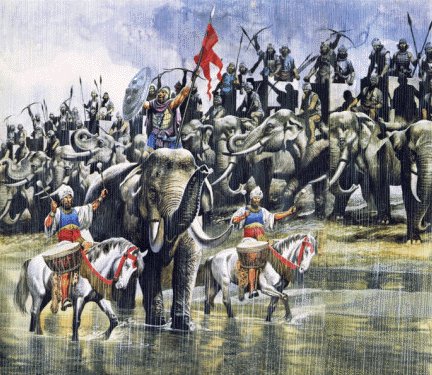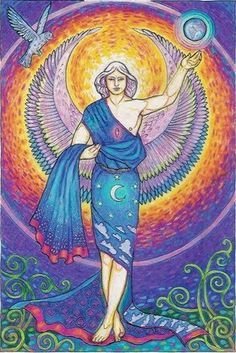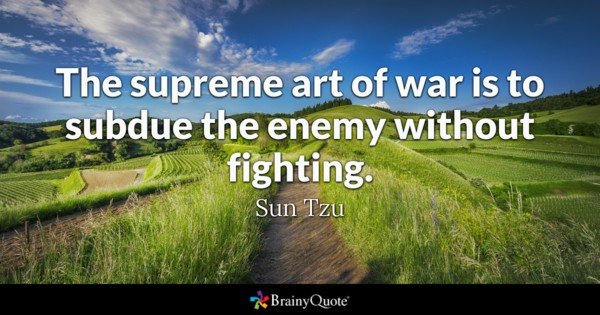The Progression of India to the East

Image Source
The triump of King Sudas over the Ten-Kings is the best episode of India's progression. Sudas, called descendant of Pijavana, is additionally expressed to be the son of Divodasa. In later Sanskrit, the name Divodasa might be interpreted "servant of heaven", yet originally dasa or Dasyu applies to a threatening non-Aryan people. They had the unique color namely black which recognized them from the Aryans, and consequently can just allude to their darker appearance, as stood out from the lighter skin color of the newcomers. Simply after rehashed victory does the word dasa come to mean slave or helot, an individual from the sudra caste, servant, or in the form Dasyu, "robber."
The name of an Aryan king should end in dasa implies that there was some recombination amongst Aryans and non-Aryans not long after 1500 B.C. The tribe over which Sudas was chief is given as the Bharatas, or maybe a unique branch of the Bharatas called the Tritsus. The modern official name Bharat for India signifies 'land of the Bharatas'. These Bharatas were unquestionably Aryans. Clearly, racial virtue made no difference to the early Aryans, selection of the autochthones was constantly conceivable and honed.
The names of Suda's opponents are additionally given. Tribe and chief at that point, with respect to quite a while a short time later, bore a similar assignment, especially to outcasts. The unfriendly names in this case are more than ten. It is sure that some of these Ten were additionally Aryans. Paktha is guessed to be identified with the modern Pakhtoon or Pathan in Afghanistan and Pakistan. They communicate in Pashto, an Indo-Iranian Aryan language.
The Rigvedic inception of these people appears to be conceivable in light of the fact that Herodotos mentions such an Indian tribe, the Paktyans. Alina signifies "bee," Matsya "fish", both clearly totemic names. Of the former nothing is known, yet Matsya tribesmen in historic times were settled close modern Bharatpur, well toward the east of the Rigvedic battlefield. For that matter, the grammarian Patanjali,gives "eastern Bharatas" for instance of excess. for there are no Bharatas with the exception of in the East.

Image Source
The eastward movement is clear, one of the ten opponents, Sigru, bears the name of the drumstick tree, a brahmin clan got from that name is known in a Kushana engraving at Mathura, however not to be found in the clan-records now surviving. The totemic nature of such tribal names isn't in question. Most astounding of all is the name Bhrigu among Sudas' foes, clearly then a tribe.
The word is philologically identified with Phrygian. A chariot made by the Bhrigus for Indra is mentioned in somewhere else with uncommon appreciation. Be that as it may, the main survival of this name from classical Sanskrit down to the present day assigns just one of the primary exogamous brahmin clan groups, still effective and vital. They came late into the brahmin fold however climbed quick.
The reason for the Ten-Kings battle was that the Ten attempted to occupy the river Parushni. This is an extend of the modern Ravi which, be that as it may, changed its course a few times. Preoccupation of the waters of the Indus system is as yet a reason for furious recriminations amongst India and Pakistan. The oily voiced Purus, however foes of Sudas, were Aryans as well as closely identified with the Bharatas. Later tradition even makes the Bharatas a branch of the Purus.
A similar clan priests in the Rigveda impartially call down condemnations and endowments upon the Purus in different hymns, which demonstrates that the contrasts amongst them and the Bharatas were not lasting. The fight was of another sort than that amongst Aryan and non-Aryan. The Purus stayed in the Harappa locale and extended their govern over the Panjab in later times. It was they who set up the most grounded battle against Alexander in 327 B.C.

Image Source
The modern Panjabi surname Puri may conceivably begin with the Puru tribe. The priest who sings of triumph over the Ten Kings has the clan name Vasishtha, still one of the traditional seven noteworthy brahmin exogamous groups. The original priest had been Visvamitra of the Kusika clan. The priestly capacity was not up 'til now particular to any one caste in the Rigveda, and in actuality the main caste distinction in the earliest Veda was of color between light-skinned Aryans and their darker foes.
As in ancient Greece or Rome, the cults of family, clan, or tribe could be and must be kept up by any male individual from the group called upon for the obligation, regardless of whether by rank, race, or custom. In spite of the fact that the different concentrated priestly offices at a fire sacrifice are recorded, there is no brahmin caste in that capacity with a restraining infrastructure of the priesthood. Vasishtha, be that as it may, was a new sort of priest. He was begotten of the seed of two Vedic gods Mitra and Varuna, once the sun and the sky god separately.
Unexpectedly, he was born of the brain of Urvasi, born likewise of a jar which got the consolidated semen of the two gods, and found clad in the lightning in a pushkara. This evidently befuddled story is really very consistent and direct. It implies that Vasishtha happened to the human agents of a pre-Aryan mother goddess and thusly had no father. Heading toward the patriarchal Aryans required some respectable father and in the meantime a foreswearing of the non-Aryan mother.
Agastya, organizer of another significant brahmin clan group still surviving, was correspondingly born of a jar. The jar speaks to the womb and along these lines the mother goddess. The seven primary brahmin clan begetters may backpedal to aged Sumerian or Indus relic as the "seven sages", their names don't tally in the different records given by brahmin sacred writings. Visvamitra is an eighth, the main authentic Aryan of the lot. The reception of such "jar-born" seers into the high Aryan priesthood was a key development.

Image Source
By such recombination of Aryan and autochthone, a new class of experts created which would eventually assert syndication of all Aryan custom - the brahmin caste. What we have of the ancient holy books has been safeguarded by this caste, rewritten by this caste, and gives a naturally finished swelled perspective of their significance. All things considered, they performed one undertaking whereof the esteem is once in a while drawn out, the digestion of generally threatening groups, alongside their numerous new cults, into one society revering common gods.
There is Rigvedic prove for the germination of a new expert brahmin priesthood that could serve more than one ace at need, Aryan or not. A sage Vasa Asvya thanks the Dasa kings Balbutha and Taruksha and calls down manifold favors upon their tribes for different blessings, which incorporated a hundred camels. The camel is uncommon in ancient Indian tradition and was not restrained even outside India till around 1200 B.C., which dates the hymn loosy.
The names Balbutha and Taruksha don't have an Aryan ring and are not somewhere else known in Sanskrit works. All this proposes additionally that a portion of the Asura titans mentioned in the Veda may have been historical Assyrians, of whom King Tiglath-Pileser III attacked and vanquished An aryan area to the extent the Helmand river. The Aryan seer of another hymn thanks none other than Bribu, chief of the Panis, for his support.
The Aryans who moved eastward varied from the first trespassers of India. A new kind of tribal slave, the dasa, was accessible for additional labor. An exceptionally particular priesthood had been formed by grouping of old and new, of pre-Aryan and Aryan. Archeologically, this period is as yet clear. just material object the hymns depict deliberately enough for recreation is the chariot. It is excessively to expect that Vedic chariots will actually one day be uncovered.

Image Source
There was no unique Aryan pottery, however the northern dim ware would soon accept this position, no specific Aryan or Indo-Aryan strategy is to be distinguished by the paleologist even at the close of the second thousand years. It is a reasonable figure that a portion of the impossible to miss Vedic gods not known somewhere else had been received from the pre-Aryans: the dawn-goddess Ushas, the craftsman-god Tvashtri who is credited with forming Indra's weapons, and the dark Vishnu who was later to locate an awesome future in India, whatever his past had been.
Of these Ushas had a well known brush with Indra on the Beas river, which ended in her bull truck being crushed and the goddess' light. Afterward, Indra and a hero Trita murdered Tvashtri's son, the three-headed priest-demon Tvashtra, who has much an indistinguishable name from the father. The hymn that depicted the murdering is allocated to the creation of the beheaded Tvashtra himself, which implies that he couldn't be wrecked, similarly as Ushas proved unable.
The three heads moved toward becoming birds, of which two in any event are known brahmin clan totems. In addition, Tvashtra is expressly named high up in the line of Upanishad instructors. More profound investigation of these legends would take us much too a long way from the principle issue, however the murdering of a three-headed demon is found in Iranian myth too and Ushas is identified with the Greek Eos. Be that as it may, the brahmins, in any event, perceived some family relationship with the adversaries of Indra and with the originally unfriendly gods they revered even in the Vedas.

Image Source

References:
http://www.ancient-origins.net
https://en.wikipedia.org/wiki/Indo-Aryan_peoples
https://en.wikipedia.org/wiki/Aryan_language
https://en.wikipedia.org/wiki/Indo-Aryan_languages
http://www.hinduwebsite.com
history indian-progression aryans philippines
It is very nice to read such information about India and its history I was very impressed by what you wrote in your wonderful post
Downvoting a post can decrease pending rewards and make it less visible. Common reasons:
Submit
Glad you like it.
Downvoting a post can decrease pending rewards and make it less visible. Common reasons:
Submit
Everything's great in Lndia.
I don't understand why this country still suffers from poverty and underdevelopment.
I think the British invasion has not allowed this country to become a super-power.
.......... For the ruling family, more than 1 billion people remain in poverty... It's a human, historical and moral injustice.
Downvoting a post can decrease pending rewards and make it less visible. Common reasons:
Submit
We can blame that to the politics.
Downvoting a post can decrease pending rewards and make it less visible. Common reasons:
Submit